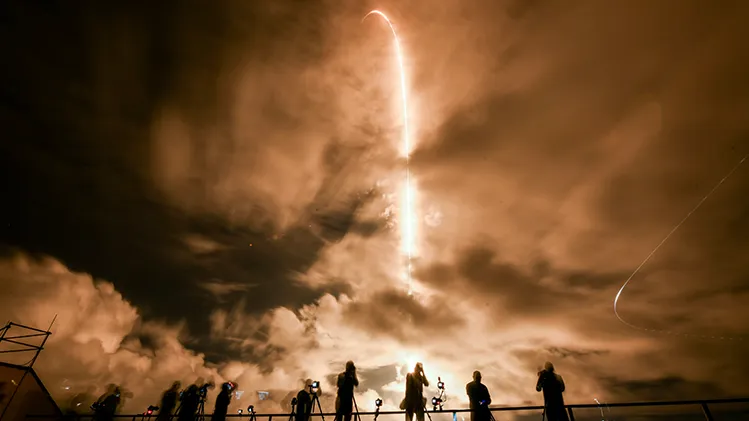What time is the 'Ring of Fire' eclipse? How to watch Wednesday's annular eclipse
A lucky few will have a chance to catch sight of another space phenomenon on Wednesday when the annular "ring of fire" solar eclipse darkens the skies.
The annular (or ring-shaped) solar eclipse will be most observable from South America, though residents of at least one U.S. state may have a chance to catch a glimpse. Occurring when the moon is at its farthest position from the sun, an annular eclipse does not produce a complete blackout and instead creates and ring light effect, hence the "ring of fire."
This time around, the celestial event will only be viewable to a small population in one U.S. state. Wondering if you can catch a glimpse? Here's what to know about watching today's "ring of fire" annular eclipse.
What time is the ring of fire annular solar eclipse?
The annular solar eclipse, also known as the "ring of fire," will occur on Wednesday, Oct. 2.
The annular eclipse will happen in phases, according to Time and Date data:
- 15:42 UTC: Partial eclipse begins. A partial eclipse occurs when the moon, sun and Earth don't perfectly align and only the outer shadow of the moon's shadow is cast on the Earth.
- 16:50 UTC: Annular eclipse begins. An annular eclipse describes the moment the moon passes between the Earth and sun, creating the the illusion of a thin ring of sunlight around the moon.
- 18:45 UTC: Maximum eclipse beings. This happens when the moon completely covers the face of the sun.
- 20:39 UTC: Annular eclipse ends
- 21:47 UTC: Partial eclipse ends
Where will the solar eclipse be viewable?

The solar eclipse will be visible from parts of South America, the Pacific Ocean, the Atlantic Ocean, and Antarctica.
Only about 175,000 people live within the path of annularity this time around, according to Time and Date and NASA. However, the number of people who could have a partial sight-line on the eclipse is much larger − about 245 million people.
Southern parts of Argentina and Chile will see the annular eclipse in its full glory. In the U.S., Hawaii is the only state expected to have a partial view of the Oct. 2 eclipse.
According to NASA, other territories and countries that could see at least a partial eclipse include:
- American Samoa
- Antarctica
- Argentina
- Baker Island, U.S. Minor Outlying Islands
- Brazil
- Chile
- Christmas Island
- Clipperton Island
- Cook Islands
- Falkland Islands
- Fiji
- French Polynesia
- Hawaii, USA
- Mexico
- New Zealand
- Niue
- Palmyra Atoll, U.S. Minor Outlying Islands
- Paraguay
- Pitcairn Islands
- Samoa
- South Georgia and South Sandwich Islands
- Tokelau
- Tonga
- Tuvalu
- Uruguay
- Wallis and Futuna

How to see the ring of fire
The 2024 "ring of fire" annular eclipse will not be viewable from the contiguous U.S. However, a partial eclipse will be viewable from Hawaii starting around 6:10 a.m. Hawaii Standard Time (HST) and ending at 7:57 a.m. HST.
Several cities in Hawaii will be able to view some of the partial eclipse in the early morning hours of Oct. 2. (all times in HST, via Time and Date):
- Hilo - Viewable between 5:44 a.m. and 7:56 a.m.
- Honolulu - Viewable between 5:45 a.m. and 7:52 a.m.
- Kailua-Kona - Viewable between 5:44 a.m. and 7:56 a.m.
- Lihue - Viewable between 5:46 a.m. and 7:51 a.m.
- Napili-Honokowai - Viewable between 5:45 and 7:53 a.m.
- Wailuku - Viewable between 5:45 a.m. and 7:54 a.m.
- Waipahu - Viewable between 5:45 a.m. and 7:52 a.m.
Safely watch the ring of fire solar eclipse
According to NASA, eye protection is necessary when looking at a partial or annular eclipse. Because the sun is never completely covered, viewers must keep safe solar viewing glasses, also called eclipse glasses, on throughout the entirety of the eclipse or use a handheld solar viewer.
Don't have any glasses or a viewer left from the last eclipse? Try a do-it-yourself indirect viewer, like a pinhole projector or funnel viewer. Remember that normal sunglasses, binoculars, and cellphone cameras are not ample protection for viewing an eclipse; safe solar viewers should comply with ISO 12312-2 standards, NASA advises.
Disclaimer: The copyright of this article belongs to the original author. Reposting this article is solely for the purpose of information dissemination and does not constitute any investment advice. If there is any infringement, please contact us immediately. We will make corrections or deletions as necessary. Thank you.






